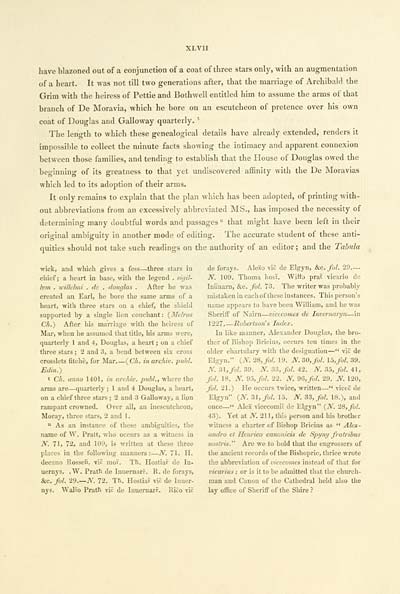Bannatyne Club > Registrum Episcopatus Moraviensis, e pluribus codicibus consarcinatum approximately A.D. MCCCC [i.e. 1400]
(63) Page xlvii
Download files
Complete book:
Individual page:
Thumbnail gallery: Grid view | List view

have blazoned out of a conjunction of a coat of three stars only, with an augmentation
of a beart. It was not till two generations after, that the marriage of Arehibald the
Grim with the heiress of Pettie and Bothwell entitled him to assume the arms of that
branch of De Moravia, which he bore on an escutcheon of pretence over his own
coat of Douglas and Galloway quarterly. l
The length to which these genealogical details have already extended, renders it
impossible to collect the niinute facts showing the intimacy and apparent connexion
betvveen those families, and tending to establish that the House of Douglas owed the
beginning of its greatness to that yet undiscovered affinity with the De Moravias
which led to its adoption of their arms.
It only remains to explain that the plan whieh has been adopted, of printing with-
out abbreviations from an excessively abbreviated MS., has imposed the necessity of
determining many doubtful words and passages u that might have been left in their
original ambiguity in another mode of editing. The accurate student of these anti-
quities should not take such readings on the authority of an editor ; and the Tabula
wick, and which gives a fcss — three stars in
chief ; a heart in base, with the legend . sigil-
Ivm . ujiOebni . de . douglas . After he was
created an Earl, he borc the same arms of a
heart, with three stars on a chief, the shield
supported by a single lion couchant: (JHielros
Ch.) After his marriage with the heiress of
Mar, when he assumed that title, his arms were,
quarterly 1 and 4, Douglas, a heart ; on a chief
three stars ; 2 and 3, a bcnd bctween six cross
crosslets fitche, for Mar. — (Ch. inarchiv. publ.
Edin.)
• Ch. anno 1401, in archiv. publ., where the
arms are — quarterly ; 1 and 4 Douglas, a heart,
on a chief three stars ; 2 and 3 Galloway, a lion
rampaut crowned. Over all, an inescutchcon,
Moray, three stars, 2 and 1.
u As an instancc of thcse ambiguities, the
name of W. Pratt, who occurs as a witness in
N. 71, 72, aud 109, is written at these three
places in the following manners : — N. 71. H.
decano RosseS. vic mof. Th. Hostia? de In-
uernys. .W. Pratti de Inuernarf. K. de forays,
&c. fol. 29.— N. 72. Th. Hostiaf vic de Inuer-
nys. Walto Prath vic de Inuernarf. Rico vic
de forays. Alexo vic de Elgyn, &c. fol. 29 —
N. 109. Thoma host. Witto prat vicario de
InQnarn, &c. fol. 73. The writer was probably
mistaken in eachof these instances. This person's
name appcars to have been William, and he was
SherifF of Nairn — vicecomes de Invernaryn — in
1227 Robertson's Index.
In like manner, Alexander Douglas, the bro-
ther of Bishop Bricius, occurs ten times in the
older chartulary with the designation — " vic de
Elgyn." (JV. 28, fol. 19. N. 30, fol. 15,fol. 39.
N. 3l,/o/. 39. N. 33, fol. 42. N. 35, fol. 4 1 ,
fol. 18. N. 95, fol. 22. N. 96,fol. 29. JV. 120,
fol. 21.) He occurs twice, written — " vicec de
Elgyn" (N. 3i,fol. 15. N. 33, fol. 18.), and
once^ — " Alei vicecomit dc Elgyn" (N. 28, fol.
43). Yet at N. 211, tliis person and his brothtr
witness a charter of Bishop Bricius as " Alex-
andro et Henrico canonicis de Spyny fratribus
is." Are we to hold that the engrossers of
the ancient records of the Bishopric, thrice wrote
the abbreviation of vicecomes instead of that for
vicarius ; or is it to be admitted that the church-
man and Canon of the Cathedral held also the
lay oflice of Sheriif of the Shire ?
of a beart. It was not till two generations after, that the marriage of Arehibald the
Grim with the heiress of Pettie and Bothwell entitled him to assume the arms of that
branch of De Moravia, which he bore on an escutcheon of pretence over his own
coat of Douglas and Galloway quarterly. l
The length to which these genealogical details have already extended, renders it
impossible to collect the niinute facts showing the intimacy and apparent connexion
betvveen those families, and tending to establish that the House of Douglas owed the
beginning of its greatness to that yet undiscovered affinity with the De Moravias
which led to its adoption of their arms.
It only remains to explain that the plan whieh has been adopted, of printing with-
out abbreviations from an excessively abbreviated MS., has imposed the necessity of
determining many doubtful words and passages u that might have been left in their
original ambiguity in another mode of editing. The accurate student of these anti-
quities should not take such readings on the authority of an editor ; and the Tabula
wick, and which gives a fcss — three stars in
chief ; a heart in base, with the legend . sigil-
Ivm . ujiOebni . de . douglas . After he was
created an Earl, he borc the same arms of a
heart, with three stars on a chief, the shield
supported by a single lion couchant: (JHielros
Ch.) After his marriage with the heiress of
Mar, when he assumed that title, his arms were,
quarterly 1 and 4, Douglas, a heart ; on a chief
three stars ; 2 and 3, a bcnd bctween six cross
crosslets fitche, for Mar. — (Ch. inarchiv. publ.
Edin.)
• Ch. anno 1401, in archiv. publ., where the
arms are — quarterly ; 1 and 4 Douglas, a heart,
on a chief three stars ; 2 and 3 Galloway, a lion
rampaut crowned. Over all, an inescutchcon,
Moray, three stars, 2 and 1.
u As an instancc of thcse ambiguities, the
name of W. Pratt, who occurs as a witness in
N. 71, 72, aud 109, is written at these three
places in the following manners : — N. 71. H.
decano RosseS. vic mof. Th. Hostia? de In-
uernys. .W. Pratti de Inuernarf. K. de forays,
&c. fol. 29.— N. 72. Th. Hostiaf vic de Inuer-
nys. Walto Prath vic de Inuernarf. Rico vic
de forays. Alexo vic de Elgyn, &c. fol. 29 —
N. 109. Thoma host. Witto prat vicario de
InQnarn, &c. fol. 73. The writer was probably
mistaken in eachof these instances. This person's
name appcars to have been William, and he was
SherifF of Nairn — vicecomes de Invernaryn — in
1227 Robertson's Index.
In like manner, Alexander Douglas, the bro-
ther of Bishop Bricius, occurs ten times in the
older chartulary with the designation — " vic de
Elgyn." (JV. 28, fol. 19. N. 30, fol. 15,fol. 39.
N. 3l,/o/. 39. N. 33, fol. 42. N. 35, fol. 4 1 ,
fol. 18. N. 95, fol. 22. N. 96,fol. 29. JV. 120,
fol. 21.) He occurs twice, written — " vicec de
Elgyn" (N. 3i,fol. 15. N. 33, fol. 18.), and
once^ — " Alei vicecomit dc Elgyn" (N. 28, fol.
43). Yet at N. 211, tliis person and his brothtr
witness a charter of Bishop Bricius as " Alex-
andro et Henrico canonicis de Spyny fratribus
is." Are we to hold that the engrossers of
the ancient records of the Bishopric, thrice wrote
the abbreviation of vicecomes instead of that for
vicarius ; or is it to be admitted that the church-
man and Canon of the Cathedral held also the
lay oflice of Sheriif of the Shire ?
Set display mode to: Large image | Transcription
Images and transcriptions on this page, including medium image downloads, may be used under the Creative Commons Attribution 4.0 International Licence unless otherwise stated. ![]()
| Publications by Scottish clubs > Bannatyne Club > Registrum Episcopatus Moraviensis, e pluribus codicibus consarcinatum approximately A.D. MCCCC [i.e. 1400] > (63) Page xlvii |
|---|
| Permanent URL | https://digital.nls.uk/81605929 |
|---|
| Description | Place of publication Edinburgh unless otherwise stated. No. 125 is relative to but not part of the club's series. |
|---|---|

